- Home
- Yvonne Navarro
Species
Species Read online
S P E C I E S
Beautiful, blond, and deadly, she is part alien and part human, a top-secret government experiment scheduled to be destroyed. But she escaped and—driven by powers not even she understands and an instinct she cannot control—she descends on Los Angeles with a single purpose: to mate and reproduce.
Now a special team of uniquely talented individuals has been assembled to stop her. The only problem is that their quarry is like nothing they’ve ever encountered, and all they have to go on is a growing trail of bodies and the knowledge that time is running out. For if they don’t catch her before she reproduces, the planet will be seeded with the spawn of an unknown species—a species genetically superior to our own and with no known predators . . .
FOR THREE MILLION YEARS. THE HUMAN RACE HAS BEEN AT THE TOP OF THE EVOLUTIONARY LADDER.
NOTHING LASTS FOREVER
DEADLY METAMORPHOSIS
Above Angela’s cooling body, the chrysalis began to break apart, cracks spidering in all directions along its glossy surface. Within the husk where the woman had found death, there was motion, an unhurried shuffling, then pressure. Like an exquisite butterfly emerging from its cocoon, a new Sil pushed her way free. Headfirst, then arms, reaching up and around to the top of the chrysalis and swinging herself carefully out and down to stand next to Angela’s corpse, reborn a fully grown and beautiful woman.
She sniffed the air, and her eyes, steely blue beneath a lovely halo of blond hair, sharpened as she studied her surroundings and the body at her feet. With slow deliberation, Sil bent and began undressing the dead woman.
SPECIES
A Bantam Book/July 1995
All rights reserved.
Copyright © 1995 by Dennis Feldman.
Cover art copyright © 1995 by Metro Goldwyn Mayer Inc.
ISBN 0-553-57404-3
Published simultaneously in the United States and Canada
Bantam Books are published by Bantam Books, a division of Bantam Doubleday Dell Publishing Group, Inc. Its trademark, consisting of the words “Bantam Books” and the portrayal of a rooster, is Registered in U.S. Patent and Trademark Office and in other countries. Marca Registrada. Bantam Books, 1540 Broadway, New York, New York 10036.
PRINTED IN THE UNITED STATES OF AMERICA
For my dad,
Marty Cochran.
Who believes in my dreams,
and still helps make them possible.
ACKNOWLEDGMENTS
As with all projects, especially surprises like this one, a lot of people helped in the making. Many thanks to my editors, Anne Groell, Jennifer Hershey, and Jennifer Steinbach, and as always, to my agent and friend, Howard Morhaim. Don VanderSluis and my dad, Marty Cochran, patiently answered another barrage of technical questions. Lots of gratitude goes to Dennis Feldman, who started this whole thing and was always available, and I stand in awe of La Bon Ami, Master Huntress of the “I Can Find Anything Search.” Abundant appreciation goes to Jeff Osier, who can remember everything and find out anything, while Linda Schroyer continues her mission of rescuing me in my ongoing war with word-processing software. I was blessed, too, with support and solid declarations of “You can do it!” from more people than I can remember here, but particularly from Don VanderSluis, my longtime friend Wayne Allen Sallee, Janna Silverstein, Amy Wasp-Wimberger, Matt Costello, and Tammy Thompson.
And finally, thanks to Johnny Algiers for the footnotes.
PROLOGUE
November 15, 1974
Arecibo, Puerto Rico
From the outside, it looked like another beautiful day in Arecibo. A bustling community settled by the Spanish over four hundred years earlier, the town went about the business of living with a sort of laid-back energy born of a tropical climate and an active industry. Plastics, farm machinery, sporting goods, clothing, and paper were manufactured in the mills and factories, while the largest distillery in the country continued the fine trade of rum-making. At one end of town, the rail yards loaded shipments on trains that would make the trip to San Juan, while at the University of Puerto Rico the students began another round of classes to sharpen their minds for the future.
The residents of the town were used to the huge Arecibo Observatory installation to the north, though many of them never knew or understood exactly what it did. The thousand-foot-wide radar-radio telescope, its antenna structures rising more than half that distance, had been there for nearly a decade and a half but today was like any other in the active lives of the people on the small inlet near the mouth of the Arecibo River.
On this fine and bright Friday, as part of the ceremonies dedicating the newly ungraded telescope, a reel-to-reel tape machine whirred into life in the Observatory’s control center in response to the carefully programmed instructions fed to it by the mainframe computer. At the computer’s keyboard sat a young man wearing thick glasses, jeans, and a Grateful Dead T-shirt, listening to someone on the other end of a telephone and nodding his head. “Yes, sir,” he said. His gaze flicked to the industrial clock above the desk, and he watched its second hand sweep around to the sixty mark, then begin another trip. “Sixty seconds and counting.” Neither he nor the party on the other end said anything, but the young man did not hang up. Across the room, an older man in a more conservative white dress shirt with the sleeves rolled up checked the position of the tape machine for the third time, then hit the pause button. He looked expectantly at his younger colleague.
Both of them stared at the clock. At minus five and counting, the young man at the computer moved his finger to a strategic position above the keyboard. The older man began counting backward in time with the measured tick of the second hand. His voice was soft and tense.
“Four . . . three . . . two . . .
“One.”
The young man at the keyboard pressed the enter key, and both turned to stare at the tape machine as the reels spun into motion and their transmission—destined for the fringes of the galaxy—began. Behind them, data began to flash across the green screen of the computer monitor, far too rapidly for either to read. It didn’t matter; they both knew the essence of the message constructed by Frank Drake, Richard Isaacman, Linda May, James C. G. Walker, and Carl Sagan:
A 1,679-bit picture portraying a counting scheme; a description of fundamental terrestrial biochemistry including five biologically significant atoms: hydrogen, carbon, oxygen, nitrogen, and phosphorus; a schematic of the DNA double helix; a representation of a human being, including dimensions; a depiction of the solar system showing that human beings inhabit the third planet; and a schematic representation of the Arecibo Observatory and a description of its dimensions.
The two men were not close. One, a family man with a boy flunking out of high school and a girl doing well in college, thought about how his wife wanted another baby and worried whether the transmission instructions were programmed properly, although he knew the programmer, Bernard Jackson, had done a perfect job. The keyboard operator thought the whole idea was cool, but didn’t believe for a moment that anything would ever hear it. He didn’t want to be sending messages into the empty reaches of the universe; he wanted to be sending satellites to explore the closer planets. As he sat at the keyboard and kept a close eye on the readouts from the computer tracking the program output, he decided he would reevaluate his major and make sure his education was aimed in the right direction.
While the town of Arecibo went about its daily living, the message of human life began its journey into space.
1992
Eighteen years had brought a lot of change to Arecibo. Sprawling across the greenery of the Puerto Rican coast, a continually expanding industry had made the town prosper. Operated by Cornell University under an agreement with the National Science Foundation, astronomy students from all ov
er the world now vied for the chance to work in the SETI facility at the Arecibo Observatory.
Miguel Perez had lucked out. The son of a coffee-farm laborer, he had earned a scholarship to the University of Puerto Rico through stubbornness and hard work. His household was poor enough to be considered below the poverty line, and he was acutely aware of the fact that he was the only family member to go beyond the first year of high school. While his peers were studying and compiling the information for their theses in air-conditioned dorms, he did his schoolwork in the hot kitchen of the three-room apartment he shared with his mother, father and two baby brothers, banging out his papers on a manual typewriter his father had found for six dollars in a junk shop.
Miguel was not bitter. Rather, he felt incredibly fortunate—life, he thought, was full of promise and adventure. Someday he would be able to do wonderful things to reward his hardworking parents, and he knew that every day he set an example for his younger siblings. He did not need to have huge amounts of money: the education he was receiving would expand his intellect and care for his future, and his family would nurture his heart. Taking care of his simple needs wasn’t even that difficult. Monitoring the computers at the facility for two hours a day gave him enough cash to buy schoolbooks and supplies and help out with the groceries at home. To help Miguel, his mother packed a homemade lunch for him every morning. Today’s fine meal was a carnitas tortilla and menudo soup; the tortilla was long gone and he was savoring the spicy soup while reviewing his spectroscopy notes.
Right now Miguel was alone in the whitewashed room, but Francis Leverton, the American exchange student, would return in about ten minutes. By then Miguel’s soup would be gone and he’d be packed up and ready to go; sometimes sitting here by himself for the last sixty minutes of his daily stint—the lunch hour—was tedious enough to make him feel dull and sleepy, and he was looking forward to the return of the two regular staff members and the brisk walk in the sunshine to his next class.
It was time for the final check of his shift, so he swallowed the last spoonful of soup then plucked the clipboard holding the transmission monitor record out of its slot and stood. Filling out the list would start him at the computer to his far left and from there he would work his way across the room. He already knew that his clipboard would look the same as it had every day since he’d started this job two months ago: a line of Xs along the left margin in the “yes” box under the heading Transmitting Properly, and three Xs along the right in the “none” boxes under Signals Received. Some things just didn’t change—
—until a red light began to blink on the receiver four feet away and he saw the needles on the computer recording devices sitting steadily in the center of the red strip that indicated they were active.
Frowning, Miguel thought the equipment was malfunctioning until he checked the electronic readouts and realized this had been going on for at least two minutes and forty seconds. More checks and hastily typed computer commands told him that the signal coming in was not a malfunction, nor could it possibly originate from Earth. Everything indicated that it was a narrow radio wave from space rather than a wide communication band, and that suggested that it was from an artificial source, not a natural phenomenon. In short, he wasn’t sure what it was.
Miguel picked up the telephone and punched in the numbers that would connect him to the office of the head of the Observatory. He had no problem finding the correct number; it was written in indelible red marker across the bottom of every computer monitor in the room. He was particularly proud of his ability to speak clearly and concisely, with no trace of hysteria in his voice as he told the person on the other end that the facility was receiving a transmission from deep space, origin and type unknown. He listened to the man’s instructions, said “Yes, sir,” and hung up the telephone without a hint of fear in his tone.
While he waited for the Observatory officials to arrive he continued his work, as he had been instructed. But by the time Miguel and his clipboard stopped at the third of the trio of display and analysis systems, his hand was shaking so badly that the X he had put in the “yes” box in the Signals Received column looked more like a thick, sprawling arrow.
1993
“I think I’m onto something,” Penny Garnock said. She leaned forward and peered intently at her computer monitor, nose nearly touching the glass. Brown hair the color of grocery bags feathered into her face and she blew it out of the way without changing position.
“You’ve said that before, wonder girl.” What he said aloud be damned, though, because inside Toyo Sagami was cheering her on with everything he had. He’d been at the NSA’s Ft. Meade, Maryland facility for two years since transferring from a smaller office in Columbus. This wasn’t the first time Toyo wished he’d had the sense to stay put, and he was sure it wasn’t the last. But . . . damn. Filed with his transfer request to Ft. Meade had been a carload of expectations—transferring so close to Washington, D.C. had to mean decoding covert operations plans, terrorist activity logs, you name it. He and Penny had gotten a few minor jobs over the past fourteen months or so, but they always ended up coming back to this one. Penny said she felt in her soul that it was based on the English language, but so far neither of them—or the other ten cryptanalysts working on the message—had gotten squat.
Toyo ran a hand through his thick black hair and typed in another experimental cipher-text code, with no result. He sighed; he’d run out of ideas on this project, and spending ninety-five percent of his time working on the same thing really sucked—especially when it was high pressure and higher competition. When the diskful of undecipherable text had first come in from Arecibo, Toyo had wanted more than anything to be the cryptanalyst who solved it. The secrets it might hold were endless—the potential keys to life in the unknown reaches of space, interstellar travel . . . anything. The text was undoubtedly an asymmetric cryptosystem and now Toyo wished anyone would break it—even sexy, shaggy-haired Penny, at whom he stayed perpetually angry because she wouldn’t go out with him.
“No, I mean seriously.” A decade and a half of staring at computer screens had gifted her with bifocals at thirty-nine, and now her eyes—the same beguiling paper-bag tan as her hair—squinted even more behind the lenses. She began banging savagely at her keyboard, and Toyo’s heart skipped slightly. She never typed like that unless she was close to success, he’d seen her do it before on the Devon Project—
“I’ve got it!” Penny said triumphantly. She whacked the enter key with enough force to make her keyboard extender vibrate, then sat back and watched the data on her screen begin to flow. There was a nerve-racking and uncommon one-second lag as the scalar processors in the SX-4 supercomputer worked their way through Penny’s final program commands, then Penny threw him a smug grin. At the same time she leaned back and crossed her hands behind her head, her gaze fixed to the monitor. Symbols that had only been a mystery moments before suddenly formed recognizable words: methane . . . oxygen . . . fuel . . . and more. When the message ANALYSIS COMPLETE flashed in the bottom left corner, she saved the file, flipped disks, and shoved in the one marked Message No. 02.92/11/07. Toyo watched open-mouthed as the symbols rearranged themselves and began to spell out the names and specific quantities of minerals, chemicals and enzymes.
“What on earth?” He abandoned his console and scooted his chair next to hers. “I . . . would you look at that!”
“It’s a DNA double helix,” Penny breathed. Her face was shining. “It’s a formula for . . . life, Toyo.
“From somewhere out there.”
1
TODAY . . .
The Mojave Desert, California
“She knows.”
Dr. Xavier Fitch jerked at the unexpected sound of Kyle Jacobson’s voice, but the lab assistant didn’t care. “Don’t be absurd,” Fitch snapped. “She’s sleeping.” He bent his head back to his work and Kyle heard him mutter, more personal ranting about all the effort and wasted time, endless hours of research and reams of paper
that had gone into this project. Kyle knew he was the only lab assistant Fitch thought might have a passably useful brain, and now he felt foolish, sniveling like a guilty five-year-old caught with his hand on the gearshift knob of the car. He didn’t care about that either.
“It doesn’t matter,” Kyle said softly. “She’s not stupid.” He ran his fingers through his too-long sandy hair and rubbed them together when they came out oily. His hair needed washing, but he hadn’t slept in thirty-six hours or been home since last Thursday—five days. He’d seen his wife a whopping three times since the final phase of the project had begun two weeks ago.
Fitch lifted his pen from the surface of the form he was filling out and from his position at the window ten feet away, Kyle could hear the noise the doctor’s teeth made as they ground together. The older man looked as if he were trying to restrain himself, then he gave in to the urge and slammed his pen on the desktop. Kyle jumped and glanced back at him, then turned back to the control booth’s window and stared out. After two years the lab still resembled a warehouse more than a scientific center, and no other vantage point in the cavernous room supported that view as strongly as this sealed observation booth. Twelve feet below was the transparent “cage” that had been completed only two weeks ago; clad in a hospital gown—at least it was one of the newer, flower-patterned ones—its occupant sprawled innocently across the width of a white-sheeted cot. Kyle was still stunned at how quickly she’d grown, but the baby-fine blond hair and guileless blue eyes undeniably belonged to a child; he estimated her age at twelve. She could’ve been an average teenager if it weren’t for the dozen or so wires running from the surface of her skin to machines and monitors parked around the interior of the glass enclosure. Other things were scattered around the girl’s cot, too: children’s picture books and a few soft toys, all examined and discarded almost immediately except for one miniature pink teddy bear. That one was tucked securely within the crook of one elbow as she slept.

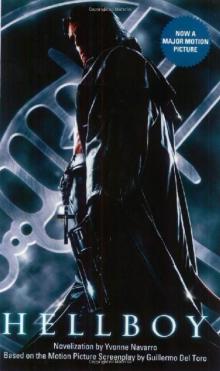 Hellboy
Hellboy Concrete Savior
Concrete Savior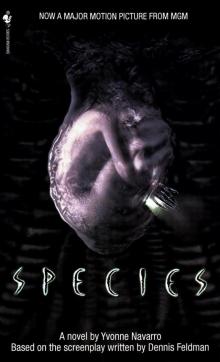 Species
Species AfterAge
AfterAge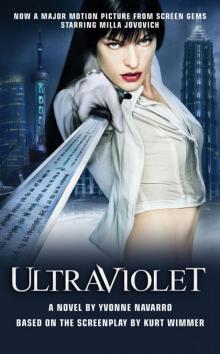 Ultraviolet
Ultraviolet Highborn
Highborn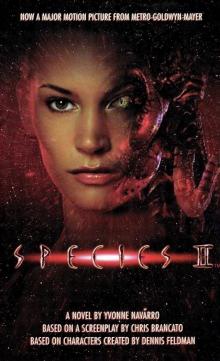 Species II
Species II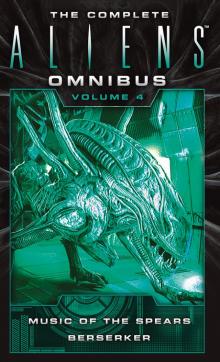 Aliens Omnibus 4
Aliens Omnibus 4 Paleo
Paleo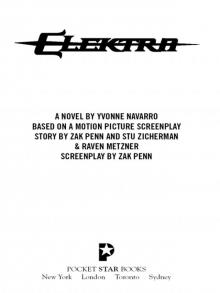 Elektra
Elektra